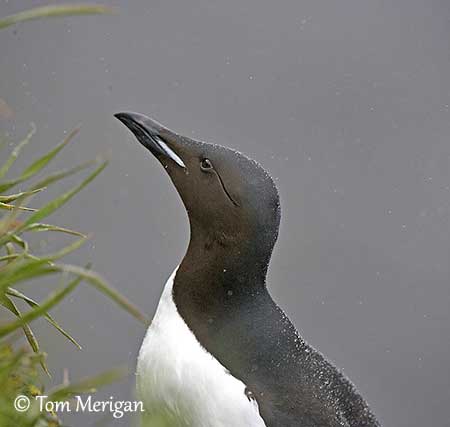Text by Nicole Bouglouan
Sources of the text:
SORA - Birds of Little Diomede Island, Alaska
Wikipedia, the free encyclopaedia
Britannica - Diomede Islands, Bering Sea
Alluring World – Discover, Experience, Live
USGS – Science for a changing world
Jet Propulsion Laboratory – California Institute of Technology
The Age and Origin of the Little Diomede Island Upland Surface
Getting to know the Diomede Islands – Yesterday and Tomorrow
Bird species list:
Ancient Murrelet - Synthliboramphus antiquus - Guillemot à cou blanc
Arctic Tern - Sterna paradisaea – Sterne arctique
Black Guillemot - Cepphus grylle - Guillemot à miroir
Black-legged Kittiwake - Rissa tridactyla - Mouette tridactyle
Black-throated Diver (Loon) - Gavia arctica - Plongeon arctique
Bluethroat - Luscinia svecica - Gorgebleue à miroir
Buff-bellied Pipit - Anthus rubescens - Pipit farlousane
Common Eider - Somateria mollissima - Eider à duvet
Common Murre - Uria aalge - Guillemot de Troïl
Common Raven – Corvus corax - Grand corbeau
Crested Auklet - Aethia cristatella - Starique cristatelle
Dark-eyed Junco – Junco hyemalis – Junco ardoisé
Eastern Yellow Wagtail - Motacilla tschutschensis - Bergeronnette de Béringie
Glaucous Gull - Larus hyperboreus - Goéland bourgmestre
Glaucous-winged Gull - Larus glaucescens - Goéland à ailes grises
Goosander - Mergus merganser - Harle bièvre
Greater Scaup - Aythya marila - Fuligule milouinan
Grey-cheeked Thrush - Catharus minimus - Grive à joues grises
Harlequin Duck - Histrionicus histrionicus - Arlequin plongeur
Herring Gull – Larus argentatus – Goéland argenté
Horned Puffin - Fratercula corniculata - Macareux cornu
Ivory Gull - Pagophila eburnea - Mouette blanche
King Eider - Somateria spectabilis - Eider à tête grise
Lapland Longspur - Calcarius lapponicus - Bruant lapon ou Plectrophane lapon
Least Auklet - Aethia pusilla - Starique minuscule
Little Auk or Dovekie - Alle alle - Mergule nain
Long-billed Dowitcher - Limnodromus scolopaceus - Bécassin à long bec
Long-tailed Duck - Clangula hyemalis - Harelde boréale
Long-tailed Jaeger - Stercorarius longicaudus - Labbe à longue queue
Northern Fulmar – Fulmarus glacialis – Fulmar boreal
Northern Wheatear - Oenanthe oenanthe - Traquet motteux
Pacific Loon (Diver) - Gavia pacifica - Plongeon du Pacifique
Parakeet Auklet - Aethia psittacula - Starique perroquet
Parasitic Jaeger or Arctic Skua - Stercorarius parasiticus - Labbe parasite
Pectoral Sandpiper - Calidris melanotos - Bécasseau tacheté
Pelagic Cormorant - Phalacrocorax pelagicus - Cormoran pélagique
Peregrine Falcon - Falco peregrinus - Faucon pèlerin
Pigeon Guillemot - Cepphus columba - Guillemot colombin
Pomarine Skua or Jaeger - Stercorarius pomarinus - Labbe pomarin
Red-breasted Merganser - Mergus serrator - Harle huppé
Red Phalarope - Phalaropus fulicarius - Phalarope à bec large
Red-throated Pipit - Anthus cervinus - Pipit à gorge rousse
Rock Sandpiper - Calidris ptilocnemis - Bécasseau des Aléoutiennes
Ruddy Turnstone - Arenaria interpres - Tournepierre à collier
Sabine’s Gull - Xema sabini - Mouette de Sabine
Sandhill Crane – Antigone canadensis – Grue du Canada
Sharp-tailed Sandpiper - Calidris acuminata - Bécasseau à queue pointue
Short-tailed Shearwater - Ardenna tenuirostris - Puffin à bec grêle
Siberian Rubythroat - Calliope calliope - Rossignol calliope
Slaty-backed Gull - Larus schistisagus - Goéland à manteau ardoisé
Snow Bunting - Plectrophenax nivalis - Bruant des neiges ou Plectrophane des neiges
Snow Goose - Chen caerulescens - Oie des neiges
Thick-billed Murre - Uria lomvia - Guillemot de Brünnich
Tufted Puffin - Fratercula cirrhata - Macareux huppé
White Wagtail - Motacilla alba - Bergeronnette grise
Yellow-billed Loon or White-billed Diver - Gavia adamsii - Plongeon à bec blanc
Otto Plantema
Trips around the world
DIOMEDE ISLANDS BIRD SPECIES
Diomede Islands are two small islands located in the Bering Strait and lying 3, 8 kilometres apart. They are separated by the U.S – Russian boundary, and consist in two rocky, mesa-like islands.
Big Diomede is the larger island and is part of the Chukotsky District of the Chukotka Autonomous Okrug of Russia.
The island resembles a mesa or tuya (a flat-topped, steep-sided volcano). This type of structure is rare and usually confined to areas formerly covered by glaciers. The island is about 29 km², and the highest point reaches 477 metres of elevation.
Little Diomede lies to the east and is part of Alaska (U.S). The total area is about 7, 3 km² and the highest point culminates at 494 metres.
The village of Diomede is on the western shore of the island, the only area without near-vertical cliffs to the water. Elsewhere on the island, the rocky slopes rise at about 40° up to the flattened top, at 350-363 metres of elevation.
The vegetation is sparse and limited to patches among the granitic boulders and outcrops.
Diomede Islands are separated by the International Date Line, and Big Diomede is 21 hours (20 in summer) ahead of Little Diomede. They are sometimes called “Tomorrow Island” for Big Diomede and “Yesterday Island" for Little Diomede.
The Bering Strait is about 82 kilometres wide between Cape Dezhnev in Chukchi Peninsula, Russia, and Cape Prince of Wales in Alaska. This is the narrowest point of the strait between the two continents.
The avifauna includes primarily seabirds and aquatic species. We can find here Laridae, Alcidae, Stercorariidae, Gaviidae, Procellariidae, but also Scolopacidae and Anseriformes.
Other birds such as the Sandhill Crane, the Pelagic Cormorant, the Peregrine Falcon, the Grey-cheeked Thrush and the Common Raven are recorded, as well as several species of Passeriformes.
During winter, an ice bridge forms between the Diomede Islands, making possible to walk from Russia to United States and vice versa. But this is strictly forbidden.
The sea-level has lowered several times during the past, making the Bering Strait emergent and forming a land bridge between Asia and North America.
Actually, the Diomede Islands are the remaining of the path that united the two huge continents. They are thought to be “tuyas” remnants of Beringia that once connected the two continents.
Today, the migratory birds fly above them or use them as stopovers during the short trip of 82 kilometres.
